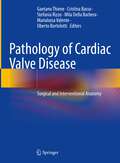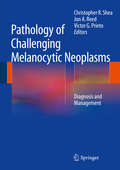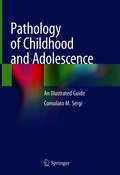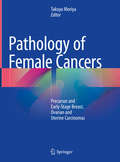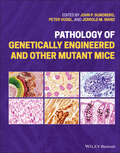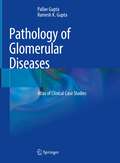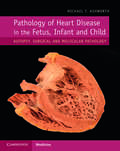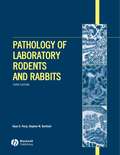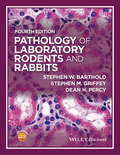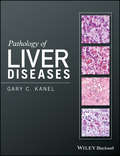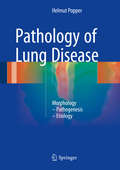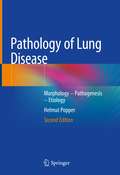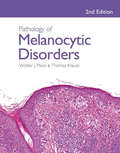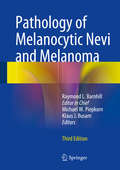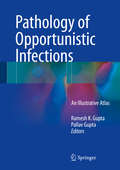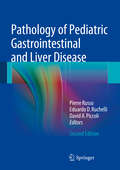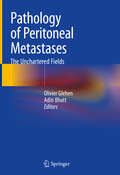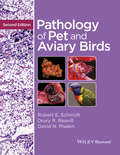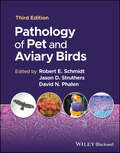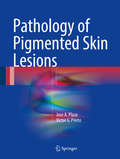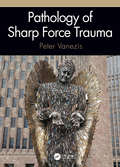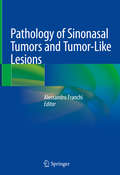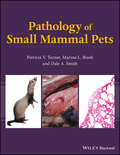- Table View
- List View
Pathology of Cardiac Valve Disease: Surgical and Interventional Anatomy
by Cristina Basso Gaetano Thiene Marialuisa Valente Stefania Rizzo Mila Della Barbera Uberto BortolottiCardiac valve diseases are a major cause of morbidity and mortality around the globe. In third world countries, inflammatory rheumatic valve disease in the young represents an endemic calamity, while in Western countries, degenerative valve diseases like senile calcific aortic stenosis and mitral valve prolapse as a result of mucoid degeneration with incompetence are major causes of death in adults/the elderly. Since the 1960s, surgical valve replacement has been the only treatment option, requiring sternotomy, cardiopulmonary bypass and cardiac arrest. Permanent anticoagulation for mechanical valves and the limited durability of biological valves constituted significant drawbacks; moreover, these surgeries often requires surgical replacement. The cardiac registry at the University of Padua, Italy, has gathered more than twelve hundred cases of failed prosthetic valves, offering a unique resource for teaching and research. Conservative valve repair using minimally invasive technique showed that replacement of the native valve with sternotomy can be spared. Moreover, in the last decade venous or arterial approaches like TAVI were developed. Presenting the essential surgical and interventional anatomy and pathology in detail, this book offers a valuable tool for cardiologists, cardiac surgeons and pathologists, as well as people in training and scientists working in the field of medical devices and biological compatibility.
Pathology of Challenging Melanocytic Neoplasms
by Victor G. Prieto Christopher R. Shea Jon A. ReedMelanocytic neoplasms are of capital importance for all surgical pathologists and dermatopathologists. These tumors span a huge range of morphologic expression and biologic behavior, are potentially of the highest medical significance and are often fraught with diagnostic pitfalls and high litigation risk. Pathology of Challenging Melanocytic Neoplasms offers a dynamic text where readers will encounter a broad spectrum of challenging melanocytic lesions, both benign and malignant and will thereby acquire a solid, working knowledge that they can immediately apply to daily diagnosis. The authors aim to clarify this often thorny field, keeping a steady focus on patient-related issues. The volume emphasizes the practical application of basic morphologic principles, immunohistochemistry and molecular methods in order to secure a confident diagnosis. Abundant illustrations display the characteristic features of the most important disease entities. Rather than being yet another encyclopedic work of reference, this volume takes a fresh approach as it resembles a series of stimulating seminars employing exemplary case material to highlight, illustrate, and succinctly discuss the key points. To this end, the reader will be guided through a series of paired cases that pose a significant diagnostic challenge. By comprehensively comparing and contrasting two related entities, each such chapter will illuminate an intellectual pathway through which an important diagnostic puzzle can be solved. To broaden the differential diagnosis even further, additional illustrative cases are added to each discussion. Algorithms and tables summarize key points. Clinically relevant, up-to-date references will be provided to guide further study. Written by experts in the field, this novel text will be of great value to surgical pathologists in practice and dermatologists as well as residents and fellows training in these specialties.
Pathology of Childhood and Adolescence: An Illustrated Guide
by Consolato M. SergiThis book covers the full range of pathologic conditions encountered during childhood and youth, including tumors and tumor-like conditions of all organ systems, with direct links to developmental biology pathways and genetics. It provides a user-friendly road map to the main diagnostic criteria and combines an organ-related approach with an explanation of the diagnostic approaches to various specific diseases and syndromes, including sequential segmental analysis of congenital heart disease. More than 500 new full-color macro- and microphotographs using more than 500 multi-photographic panels are included to provide a realistic basis for comparison macroscopically and under the lens, and summarizing tables highlight key information in the concise form required for at-a-glance review. Pathologists will find the book very helpful when signing out complex and challenging cases, and it will also prove invaluable for exam preparation and continuing medical education.
Pathology of Female Cancers: Precursor and Early-Stage Breast, Ovarian and Uterine Carcinomas
by Takuya MoriyaThis book focuses on precursor lesions, borderline lesions, and early carcinomas of female-specific organs from the standpoint of pathology. In 2012, WHO Classification of Tumours of the Breast was revised and subsequently, in 2014, the WHO Classification of Tumours of Female Reproductive Organs was revised. In these latest versions, several new concepts are addressed that were not described in the previous editions, and many of them are related to the awareness of the specific pathogenesis of tumors in female patients. Although some of these issues are still controversial, several paradigm shifts should be understood by medical scientists. Thus researchers, diagnostic pathologists, and clinicians must share current information about what is taking place in the field and what the next issue to resolve is. This volume greatly broadens the reader’s understanding of the new concepts and paradigm shifts, as it includes information on how to diagnose and make differential diagnoses on a practical basis and also provides a thorough explanation of the molecular–clinicopathologic basis of the new concepts. The book thus benefits gynecologists, breast surgeons, gynecologic–medical oncologists, and cytotechnologists.
Pathology of Genetically Engineered and Other Mutant Mice
by Peter Vogel John P. Sundberg Jerrold M. WardPATHOLOGY OF GENETICALLY ENGINEERED AND OTHER MUTANT MICE An updated and comprehensive reference to pathology in every organ system in genetically modified mice The newly revised and thoroughly updated Second Edition of Pathology of Genetically Engineered and Other Mutant Mice delivers a comprehensive resource for pathologists and biomedical scientists tasked with identifying and understanding pathologic changes in genetically modified mice. The book is organized by body system, and includes descriptions and explanations of a wide range of findings, as well as hundreds of color photographs illustrating both common and rare lesions that may be found in genetically engineered and wild type mice. The book is written by experienced veterinary and medical pathologists working in veterinary medical colleges, medical colleges, and research institutes. Covering the latest discoveries in mouse pathology resulting from advancements in biotechnology research over the last 30 years, this singular and accessible resource is a must-read for veterinary and medical pathologists and researchers working with genetically engineered and other mice. Readers will also benefit from: A thorough introduction to mouse pathology and mouse genetic nomenclature, as well as databases useful for analysis of mutant mice An exploration of concepts related to validating animal models, including the Cinderella Effect Practical discussions of basic necropsy methods and grading lesions for computational analyses Concise diagnostic approaches to the respiratory tract, the oral cavity and GI tract, the cardiovascular system, the liver and pancreas, the skeletal system, and other tissuesl As a one-stop and up to date reference on mouse pathology, Pathology of Genetically Engineered and Other Mutant Mice is an essential book for veterinary and medical pathologists, as well as for scientists, researchers, and toxicologists whose work brings them into contact with genetically modified mice.
Pathology of Glomerular Diseases: Atlas of Clinical Case Studies
by Ramesh K. Gupta Pallav GuptaThis book provides clear understanding of morphological appearances of various glomerular lesions encountered in a wide range of diseases involving renal glomeruli. Chapters cover various diseases with each chapter including a brief text and multiple colored microphotographs depicting the distinctive morphological features of glomeruli as may be encountered in these diseases. It presents complete clinical history with thorough lab workup and other related investigations as considered essential for proper evaluation of the patient. The book provides systemic approach for proper diagnosis of the underlying disease condition in view of the clinical workup and renal biopsy assessment. It provides visual understanding of the glomerular pathology that helps the consultant nephrologist to have a clear understanding of underlying renal disease thus helping in proper evaluation and appropriate therapeutic management of the patient. It may also guide to predict the likely prognostic outcome of the patient. This book is not only helpful to renal pathologists and nephrologists but also serves as a valuable resource for clear understanding of the glomerular lesions to the beginners and postgraduates in nephrology and renal pathology and other physicians managing the patients of renal diseases
Pathology of Heart Disease in the Fetus, Infant and Child: Autopsy, Surgical and Molecular Pathology
by Michael T. AshworthIn recent years, there have been no books published on paediatric cardiac pathology despite enormous developments in genetics, a marked explosion of paediatric transplant programmes, surges in knowledge of fetal cardiac pathology and understanding of congenital heart disease, and the emergence of a flourishing cardiac imaging discipline. This book will be the first unified and comprehensive source of reference for childhood heart disease, covering the full field of paediatric cardiac pathology, in one volume. Comprising the twenty-five year experience of a single pathologist, the full spectrum of the pathology of heart disease, from the fetus to the adult, is uniquely presented here. Richly illustrated, with over 800 colour photographs, general and paediatric pathologists alike will be able to examine the microscopic features of the conditions described, with a specific focus on metabolic disease for practitioners worldwide.
Pathology of Laboratory Rodents and Rabbits
by Dean H. Percy Stephen W. BartholdPathology of Laboratory Rodents and Rabbits has become a standard text for both veterinary pathologists and veterinarians in laboratory animal medicine. Newly recognized infectious diseases continue to emerge and molecular methods for studying infectious agents are becoming widely used for the classification of these and previously known pathogens. With the ongoing development and perfection of genetic engineering techniques, the use of genetically engineered mice in the research laboratory continues to grow exponentially.This new edition features updates throughout with increased emphasis on timely topics such as infectious diseases in genetically engineered mice. Diseases covered include viral infections, bacterial infections, parasitic diseases, nutritional and metabolic disorders, behavioral disorders, aging and degenerative disorders, environment-related disease, and neoplasms. Organized by species, coverage includes mice, rats, hamsters, gerbils, guinea pigs, and rabbits. Veterinary pathologists, laboratory animal veterinarians, and students will appreciate the concise organization and easily accessible information on key diagnostic features, differential diagnoses, and significance of diseases.
Pathology of Laboratory Rodents and Rabbits
by Dean H. Percy Stephen W. Barthold Stephen M. GriffeyNow in its fourth edition, Pathology of Laboratory Rodents and Rabbits has become a standard text for veterinary pathologists, laboratory animal veterinarians, students, and others interested in these species. * The standard reference on the pathogenesis and cardinal diagnostic features of diseases of mice, rats, hamsters, gerbils, guinea pigs, and rabbits * Expanded coverage of rabbit disease, normal anatomic features, and biology * Over 450 color photographs illustrating gross and microscopic pathology * Companion website offering images from the text in PowerPoint
Pathology of Liver Diseases
by Gary C. KanelPathology of Liver Diseases is a rapid reference consultation tool that uses both book and online material to present a whole range of liver disorders. The book emphasizes not only the pathology seen in biopsy and surgical material, but also the most pertinent clinical and laboratory findings including epidemiology, etiologic and pathophysiologic concepts, and the differential diagnoses. Key references appear at the end of each chapter. The book is also accompanied by a companion website: www.wiley.com/go/kanel/liverpathology It contains the following online material: A complete Reference List. A Library that contains over 860 images of the various liver diseases, which adds to over 540 images that are in the book itself. Additional Tables that address in detail the grading and staging of various liver diseases such as viral hepatitis and fatty liver diseases. 140 Case Examples, which include over 420 images that demonstrate the various ways many of these disease entities clinically present. A PowerPoint presentation entitled “Liver Transplantation – Surgical Procedure”, which includes photographs from the operating table of the step-by-step process in liver transplantation. Pathology of Liver Diseases provides gastroenterologists and pathologists with a multi-media, well-illustrated, and concise guide to the pathology and clinical diagnoses of liver disorders.
Pathology of Lung Disease
by Helmut PopperThis well-illustrated textbook covers the full range of lung and pleural diseases from the pathologic standpoint. Both diseases of adults and pediatric lung diseases are presented. The book will serve as an excellent guide to the diagnosis of these diseases, but in addition it explains the disease mechanisms and etiology. Genetics and molecular biology are also discussed whenever necessary for a full understanding. The author is an internationally recognized expert who runs courses on lung and pleural pathology attended by participants from all over the world. In compiling this book, he has drawn on more than 30 years' experience in the field.
Pathology of Lung Disease: Morphology – Pathogenesis – Etiology
by Helmut PopperThis well-illustrated book covers the full range of lung and pleural diseases from the pathologic standpoint. It has been updated from the first edition by including the most recent molecular data for the different lung diseases, tumor as well as non-tumor ones. New diagnostic tests are included, new aspects for the understanding of diseases have been added. Both diseases of adults and pediatric lung diseases are presented. The chapter on lung development has been expanded due to the many new findings being reported since the first edition.The book will serve as an excellent guide to the diagnosis of these diseases, but in addition it explains the disease mechanisms and etiology. Genetics and molecular biology are also discussed whenever necessary for a full understanding. The author is an internationally recognized expert who runs courses on lung and pleural pathology attended by participants from all over the world. In compiling this book, he has drawn on more than 30 years’ experience in the field.
Pathology of Melanocytic Disorders 2ed
by Walter Mooi Thomas KrauszThis authoritative reference work and practical bench book provides a thorough clinico-pathologic analysis of melanocytic disorders, as well as effective practical guidance in the diagnosis of problem lesions. The authors, both renowned experts in surgical pathology of tumors, expansively discuss clinical and microscopic characteristics of a very w
Pathology of Melanocytic Nevi and Melanoma
by Raymond L. Barnhill Michael W. Piepkorn Klaus J. BusamHighly acclaimed and considered the leading reference in the field, Pathology of Melanocytic Nevi and Malignant Melanoma has once again been fully revised and updated to reflect the most recent advances and techniques in the field of melanoma pathology. The successful focus and format of the previous editions have been preserved. Each lesion and diagnosis is clearly illustrated with the aid of a wealth of digitally enhanced full-color photomicrographs. A concise description of the clinical features, histopathology, differential diagnosis, and the most important characteristics of each lesion provides readers with a quick yet comprehensive overview of each topic covered. Pathology of Melanocytic Nevi and Malignant Melanoma is the essential reference for every practicing dermatopathologist, pathologist, dermatologist, and cancer research scientist today.
Pathology of Opportunistic Infections
by Ramesh K. Gupta Pallav GuptaThis book presents the morphological details of various opportunistic pathogens for prompt identification, which is essential for the proper management of various bacterial, viral, fungal and parasitic infections encountered in immunocompromised patients. Over the past few decades, certain therapeutic advances -such as organ transplantation, prolonged use of steroids and other immunosuppressants for various diseases and chemo-radiotherapy for the treatment of malignant tumors- have, in addition to improving patient survival, also contributed to significant aberrations in the patients' host defense mechanisms. Further, due to compromised host resistance, certain clinical conditions such as HIV/AIDS, diabetes mellitus, and major organ-related problems like chronic renal failure, chronic liver and chronic lung diseases etc. , make these patients potentially vulnerable to a variety of opportunistic infections. The challenges posed by the opportunistic pathogens are enormous. Early clinical suspicion, prompt morphological identification and timely management are essential so as to prevent high morbidity and mortality associated with these infections. These pathogens often go unnoticed due to a lack of familiarity with their morphological appearances in the context of histopathological and/or cytological evaluation.
Pathology of Pediatric Gastrointestinal and Liver Disease
by Eduardo D. Ruchelli Pierre Russo David A. PiccoliPathology of Pediatric Gastrointestinal and Liver Disease provides the pediatric pathologist, the GI or general pathologist, and the pediatric gastroenterologist with the most complete and current reference on the subject. With an emphasis on clinical-pathological correlation, the book includes in-depth discussions on disorders and issues that are frequently encountered but for which up-to-date information is often not readily available, as well as infrequent disorders unique or specific to children that are not covered in standard texts. Among the topics considered are malabsorption and motility disorders, immunodeficiencies, including AIDS, developmental malformations, food allergies, cystic diseases of the liver, hepatic tumors, and esophageal and pancreatic disorders. Many new illustrations and electron micrographs are included in this edition, and the high-quality endoscopic and radiographic images permit ready correlation with the pathologic principles under discussion.
Pathology of Pediatric Gastrointestinal and Liver Disease
by Eduardo D. Ruchelli Pierre Russo David A. PiccoliTen years have elapsed since the printing of the second edition of this book. Since then there's been a veritable explosion of information coming mainly from the field of molecular diagnostics, which bear particular importance in the classification and treatment of Infantile enteropathies, disorders associated with immunodeficiencies, the classification of intestinal polyps and polyposis syndromes in childhood, cholestatic and metabolic disorders of childhood, liver tumors and transplantation pathology, all of which were major subjects explored in our previous editions. In this updated third edition, most of the chapters have been extensively revised to incorporate updated understanding in pathogenesis and terminology. For example, the widespread use of genetic panels and next generation sequencing in the diagnosis of cholestatic disorders of infancy and childhood, not widely available when the last edition was being prepared, prompted the writing of an entirely new chapter reflecting these advances by a new set of authors. Similarly, progress in diagnosis and classification of liver tumors justified an entirely new chapter on liver tumors that incorporates newer patient stratification in treatment protocols and reflects the new WHO classification of liver tumors. Pathology of Pediatric Gastrointestinal and Liver Disease 3rd Edition provides the pediatric pathologist, the GI or general pathologist, and the pediatric gastroenterologist with the most complete and current reference on the subject. It includes in-depth discussions on disorders and issues that are frequently encountered but for which up-to-date information is often not readily available, as well as infrequent disorders unique or specific to children that are not covered in standard texts.
Pathology of Peritoneal Metastases: The Unchartered Fields
by Aditi Bhatt Olivier GlehenThis book covers some well-known and some unexplored pathological aspects of management of peritoneal metastases and should be read by both surgeons and pathologists involved in the management of peritoneal surface malignancies. The evaluation of cytoreductive surgery specimens is explored for the prognostic information it can provide and recommendations for evaluation of such specimens are provided. The pathways and patterns of peritoneal dissemination and their clinical implications on the extent of surgery performed and other aspects of management are discussed for some common peritoneal tumours. The exploratory studies presented here provide a new perspective on the surgical resection of peritoneal metastases. Other important aspects of pathological evaluation like pathological response to chemotherapy, diagnosis and classification of rare peritoneal tumors have also been covered in different chapters. Keeping in sync with the progress in molecular oncology, the role of molecular oncology in the current and future management of peritoneal metastases is addressed for different tumors.
Pathology of Pet and Aviary Birds
by David N. Phalen Drury R. Reavill Robert E. SchmidtPathology of Pet and Aviary Birds, Second Edition provides a comprehensive reference to the gross and histologic features of diseases seen in pet and aviary birds, with more than 850 images depicting disease lesions. * Provides a complete resource for identifying both common and not-so-common diseases in a wide range of avian species * Includes more than 850 full-color images to show disease lesions * Offers context for the interpretation of pathologic findings, promoting an understanding of the pathogenesis and epizootiology of disease * Adds information on pigeons and chickens, pathophysiology, prognosis and trends, and globally relevant diseases * Aids pathologists, diagnosticians, and avian veterinarians in identifying lesions in pet birds
Pathology of Pet and Aviary Birds
by David N. Phalen Robert E. Schmidt Jason D. StruthersPathology of Pet and Aviary Birds A complete reference for veterinary pathologists, residents, and students interested in avian diseases The revised third edition of Pathology of Pet and Aviary Birds delivers a comprehensive reference to gross and microscopic lesions found in birds, as well as the implications of these diseases. This third edition includes improved coverage of normal anatomy and of advanced diagnostic techniques, including special stains, immunohistochemistry, in situ hybridization, and molecular diagnostics. The authors offer an extensive collection of more than 1200 high-quality, full-color images. New chapters cover the postmortem examination; gross and microscopic anatomy; advanced diagnostics; and cytology. Specific chapters address diseases of passerines, Columbidae, and raptors, and other chapters are intuitively organized by body system. The book also provides: A thorough introduction to the preparation and interpretation of cytological samples Comprehensive tables of infectious diseases and published avian primers and IHC markers Practical discussion of diseases of the liver, urinary system, reproductive system, respiratory system, cardiovascular system, nervous system, alimentary system, integument, special senses, and more.High-quality and annotated macroscopic and microscopic images that bolster the text and benefit the reader Pathology of Pet and Aviary Birds is an essential resource for veterinary pathologists and pathology residents, and will also benefit avian practitioners and veterinary students with an interest in diseases of pet birds and birds in avicultural collections. As many diseases in captive birds also manifest in wild birds, the book will appeal to those interested in the diseases and pathology of wild birds.
Pathology of Pigmented Skin Lesions
by Victor G. Prieto Jose A. PlazaThis book offers a practical approach to the histologic analysis of a wide range of melanocytic skin lesions, including various nevi and different forms of melanoma, as well as pigmented non-melanocytic lesions. In addition, sentinel node biopsy findings and the use of special ancillary studies are covered in detail. Each chapter presents illustrative cases that document the route to correct diagnosis. An important feature of the book is the clinical-pathologic correlation of challenging melanocytic tumors; accordingly, it will appeal not only to pathologists (general surgical pathologists and dermatopathologists) but also to dermatologists (including dermatopathologists). The book contains some 250 color photos as well as tables and algorithms designed to assist in the diagnosis of difficult cases.
Pathology of Sharp Force Trauma
by Peter VanezisPathology of Sharp Force Trauma illustrates and details sharp force trauma as seen in forensic pathology case work as well as in the clinical setting, outlining how one informs the other in interpreting such trauma for medico-legal purposes. For the purposes of discussion, the author defines sharp force trauma as: "The application of force to produce an injury which results in a clear division or separation of the skin and underlying tissues". Sharp force trauma may be caused by all manner of implements with a sharp edge and/or pointed end, whether or not they have been produced for use as a weapon, and includes knives, broken glass, scissors and many others, to name but a few. Certain tools, such as axes or machetes, combine a sharp edge with heavy weight and produce injuries with both sharp and blunt impact elements. In many countries, with the exception of those where firearms are readily available, sharp force trauma—particularly the use of knives—is the most common method of homicide and a frequent source of morbidity seen in emergency departments. Also, there has recently been an alarming upsurge in the use of knives in gang-related assaults and in terrorist incidents. As such, the book takes a comprehensive approach in explaining the different aspects of such trauma, most importantly the manner in which the victim has died. This includes cases of homicide, suicide or accident, indicating the type of weapon responsible, explaining how it was used, and presenting other such information to the investigation of such cases. Features: • Includes over 400 full-color graphic and illustrative images throughout • Addresses all aspects of the investigation including trauma, crime scene findings, post-mortem examination, characteristics of injuries and categorization into homicide, suicide or accident • Covers the biomechanics of knife trauma and tool mark examination techniques to identify implements used • Illustrates penetrating injuries caused by pointed implements which have linear components, such as arrows, nails, spears, stakes and others • Details cutting, penetrating, and other sharp force injuries resulting from medical intervention in a healthcare environment, such as might occur during surgical procedures • Examines sharp injuries caused by domesticated and wild animals • Written by one of the premier forensic pathologists in the world with over 40 years of first-hand case experience Pathology of Sharp Force Trauma is the first substantive book published in English to look exclusively at this subject. Although primarily intended for pathologists and clinicians who are involved in the examination of such injuries in the post-mortem room or in a hospital environment, it will also be of interest to medical examiners, police and criminal investigators, attorneys and legal professionals, personnel in other forensic disciplines, and all doctors and medical students with an interested in trauma and its management.
Pathology of Sinonasal Tumors and Tumor-Like Lesions
by Alessandro FranchiThis book provides a comprehensive, up-to-date review of the field of diagnostic histopathology of sinonasal tumors and tumor-like lesions. It includes well-known and recently described structures, focusing on their epidemiological, clinical, radiological, and molecular features. It also discusses the latest surgical and medical treatment of these tumors. Primarily written for pathologists and pathology residents, the topics discussed make it a valuable resource for head and neck surgeons, radiologists, oncologists, and other clinical physicians. Written by experts in the field, this book further our understanding of the pathology of sinonasal tumors.
Pathology of Small Mammal Pets
by Patricia V. Turner Marina L. Brash Dale A. SmithPathology of Small Mammal Pets presents a ready reference for veterinarians, veterinary pathologists, and technicians who work with small mammal companion animals. Provides up-to-date, practical information on common disease conditions in small mammal companion animals Offers chapters logically organized by species, with comprehensive information on diagnosing diseases in each species Takes a practical, system-based approach to individual disease conditions Covers clinical signs, laboratory diagnostics, gross pathology, histopathology, and differential diagnoses in detail Includes relevant information for conventional breeding operations and breeding facilities, with strategies for disease management in herds and colonies Features information on normal anatomy in included species to assist in recognizing pathology
Pathology of Solid Organ Transplantation
by Hanlin L. Wang Helen LiapisBecause of the progress in diagnostic transplantation pathology interpretation of transplant biopsies is increasingly becoming an attractive field for general surgical pathologists. The book focuses on the pathology of transplantation in the following organs: kidney, liver, lungs, heart, pancreas and small intestine. An introductory section addresses common entities that may complicate all transplant recipients such as infections, post-transplant lymphoproliferative disease and graft versus host disease, followed by 6 sections with detailed manifestations of rejection in each organ. This comprehensive, well-illustrated book serves the needs and meets the requirements of pathologists in training and those practicing in centers with limited volume of transplant biopsies in daily practice.
